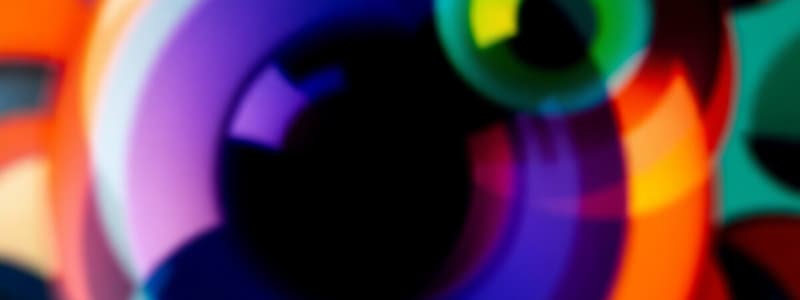Podcast
Questions and Answers
What determines the power of a lens?
What determines the power of a lens?
- The thickness of the lens material
- The distance from the lens to the object being viewed
- The color of the light passing through the lens
- The curvature of the lens and the refractive index of the material (correct)
What type of image can be captured on a screen?
What type of image can be captured on a screen?
- Inverted images only
- Real images (correct)
- Upright images only
- Virtual images
Which statement accurately describes virtual images?
Which statement accurately describes virtual images?
- They are formed by the actual convergence of light rays
- They cannot be captured on a screen and are always upright (correct)
- They can be larger than the object
- They are always inverted
How do convex lenses affect parallel light rays?
How do convex lenses affect parallel light rays?
What is the relationship between focal length and lens power?
What is the relationship between focal length and lens power?
Flashcards
Convex lens
Convex lens
A lens that bulges outwards, causing parallel light rays to converge at a single point called the principal focus.
Principal focus
Principal focus
The point where parallel light rays converge after passing through a convex lens.
Concave lens
Concave lens
A lens that caves inwards, causing parallel light rays to disperse or spread out.
Real image
Real image
Signup and view all the flashcards
Virtual image
Virtual image
Signup and view all the flashcards
Study Notes
Lenses and Light
- Lenses use refraction to focus or disperse light
- Convex lenses bulge outwards, causing parallel light rays to converge at the principal focus (also called the focal point)
- Convex lenses are also called converging lenses
- Concave lenses cave inwards, causing parallel light rays to disperse or spread out
- Lenses have a principal focus on both sides, equidistant from the center
- The focal length is the distance between the principal focus and the center of the lens.
- A shorter focal length indicates a more powerful lens, meaning it refracts light more strongly.
- Lens power can be increased by making the lens more curved or using a material that refracts light more strongly.
Real and Virtual Images
- Images form at points where light rays from a point on an object appear to converge
- Real images are formed when light rays actually converge. These images can be captured on a screen.
- Virtual images are formed when light rays do not actually converge. These images cannot be captured on a screen.
- Examples
- Real image: The image formed on the retina of your eye
- Virtual image: The image you see in a mirror
- Real images can be either upright or inverted, larger or smaller than the object.
- Virtual images are always upright and smaller than the object.
Studying That Suits You
Use AI to generate personalized quizzes and flashcards to suit your learning preferences.




